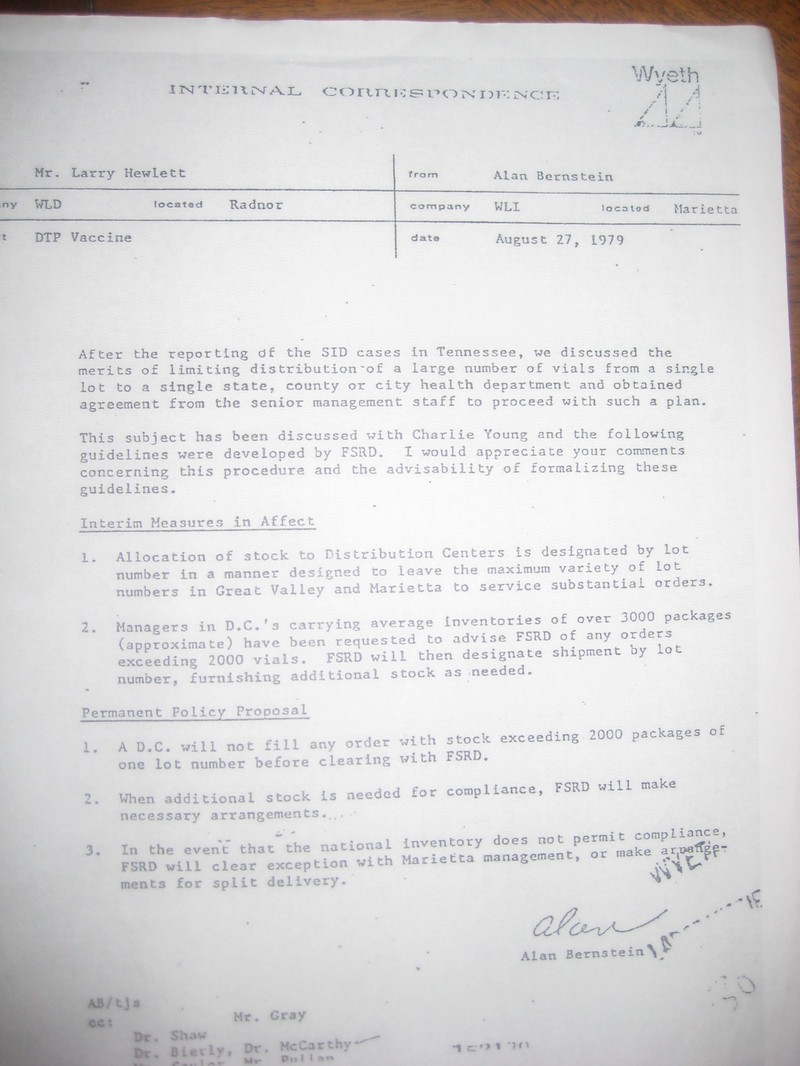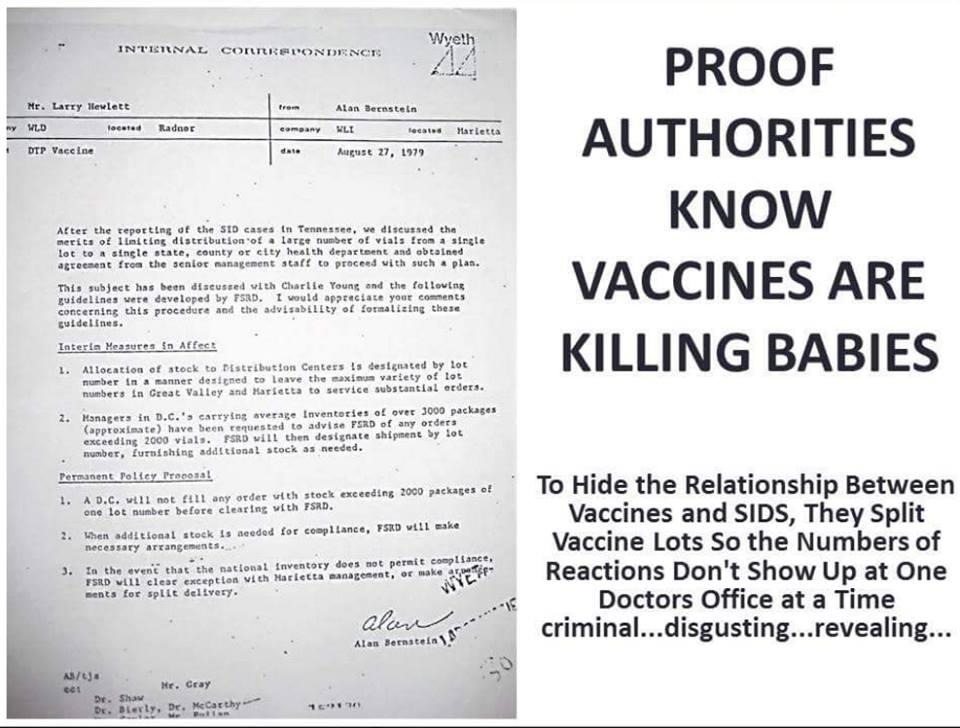Wyeth Lederle
DPT
Vax
Olmsted on Autism: 1979 Wyeth Memo on DPT
http://www.ageofautism.com
By
Dan Olmsted
Now that my Age of Autism colleague J.B. Handley has
demonstrated the role of Wyeth in funding Every Child By Two (HERE) --
the vaccine initiative that Rosalynn Carter, Paul Offit and Amanda Peet boosted
a week ago -- I think it's time to share a piece of paper someone slipped me a
while back. It looks innocuous enough -- an inter-office memorandum from 1979 (Click
HERE for the pdf)* about distribution of Wyeth's DPT vaccine. But read
closely -- a series of SIDS deaths in Tennessee is prompting Wyeth officials to
make sure that vials from a single lot don't get distributed to a single state,
county or health department.
The memo says "senior management staff" gave the OK to proceed with the plan.
I am going to refrain from interpreting this document -- although, if there is
an interpretation besides the obvious one that Wyeth didn't want correlations
being drawn between DPT vaccine lot numbers and SIDS deaths, I can't think of it
right now. And sure, it can be argued this is ancient history -- the vaccine has
been changed, what happened in 1979 does not necessarily reflect what's
happening today in the debate over adverse events following vaccination, and so
on.
Except ...

Click on the photo to bring up a full-sized pop up window. You can change the
percent view in the lower right hand corner to see the entire doc. The PDF file
has the full doc, fully legible as well.
...except there is an analogy here that goes way beyond the memo. Barbara Loe
Fisher and Harris Coulter lay it all out in "A Shot in the Dark," subtitled "Why
the P in the DPT vaccination may be hazardous to your child's health." Barbara
is regularly portrayed in the media as an anti-vaccine zealot, but the book's
discussion of what happened in Tennessee is pretty convincing. (And she was
instrumental in getting a safer version of the vaccine onto the market.) From
the book:
"When statistics are applied to the study of vaccines, political immunology
demonstrates its infinite flexibility: statistical evidence demonstrating cause
and effect is denied, when this same evidence, applied to any other branch of
medicine, would be accepted without question," Coulter and Fisher write.
"This convenient method of reasoning was displayed with particular clarity in
connection with the government's investigation of SIDS deaths in Tennessee. In
1978-79, eleven babies were found to have died within eight days of a DPT
vaccination. Nine of the eleven had been vaccinated with the same lot of
pertussis vaccine, Wyeth #64201 and five (four from the same lot) had died
within twenty-four hours of vaccination.
"A statistical analysis of the clustering of deaths revealed that the likelihood
of observing four or more deaths occurring randomly on any of the first eight
days after the use of lot #64201 was 3 in 100. ... E.B. Mortimer later reported
that the probability of this being a chance association was even lower --
between 2 and 5 in 1,000.
"The statistical evidence in favor of a connection
between the deaths and the DPT shot was strong. Would the medical authorities
bite the bullet and admit the vaccine was related to the deaths? Absolutely
not."
It's a long and unpleasant tale, but when all was said and done, "the
tombstone was placed on what happened in Tennessee three years later, in the
September 1982 issue of the Journal of Pediatrics, when Bernier and his
colleagues at the CDC wrote their epitaph on the infant deaths. ... They ...
made this amazing statement: 'Whether or not this temporal association reflects
a causal relationship remains undetermined; we found no evidence to support such
a causal association.'"
Fisher and Coulter mention the Wyeth memo, saying the
company "apparently also decided to act to prevent a clustering of deaths
following DPT vaccination from a single lot from ever occurring again in a
single geographical area." They don't reproduce the actual memo; as far as I
know, this is the first time it has been published. (And no, neither Fisher nor
Coulter was my source.)
It packs quite a wallop, doesn't it? Since these are
described as "Interim Measures In Affect" (sic!), and include a "Permanent
Policy Proposal" to put into effect (sick!), wouldn't it be interesting to know
how they distribute lots these days? Is this the kind of approach that Rosalynn
Carter and Amanda Peet (I'll leave Paul Offit out of this) want to be hooked up
with? Might they consider asking their benefactors for an explanation, since as
far as I know none has been forthcoming although the memo's existence has been
known for a couple of decades, at the least? Do the drug companies, the HMOs,
the AAP and the CDC really have a track record of tracking down every report of
side effects, encouraging the public to make use of the VAERS system and
vigilantly monitoring the VSD database? Are they the ones we want to trust to
tell us whether there is any "causal association" between vaccines and SIDS, or
autism, or asthma, or ADD?
I vote no. I also can't help pointing out that A Shot in
the Dark was first published in 1985, just before the modern Age of Autism
began. Too bad no one in a position to do anything about it took seriously the
deep and disturbing implications of this incident -- and the continuing power of
"political epidemiology" to bury its mistakes in unmarked graves.
--
Dan Olmsted is Editor of Age of Autism.
* Thanks to Ginger Taylor of Adventures
In Autism for help in turning a 29 year old piece of paper into files.
Posted by Age
of Autism on August 12, 2008

In the 1970s Wyeth Pharmaceuticals had sent an entire lot
of DTP vaccines to be administered to newborns in middle Tennessee. This caused
many, many cases of SIDS all in a close proximity and it was impossible to deny
the vaccines were at fault. Because of this, Wyeth changed their policy on how
vaccine lots are distributed. Instead of just shipping off each lot manufactured
together, they began breaking up the lots and sending them all over the country
so the cause of the SIDS cases wouldn't be so obvious... a practice still used
by all pharmaceutical companies today. Here is the internal memo discussing this
decision.

